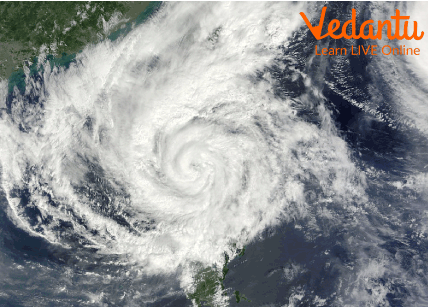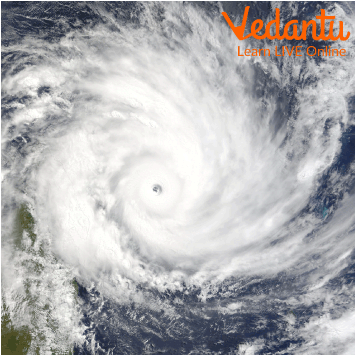




What Is a Cyclone? Definition, Causes, and Impact Explained
Whenever whirlpools are formed in the atmosphere due to specific wind masses, it is called a cyclone. Cyclones are the deadliest of atmospheric disasters! These are areas of low pressure, around which lines of rising air pressure are found! In this, the air pressure gradually increases as we move from inside to outside.
Therefore, the speed of wind is transmitted from the periphery to the centre, whose direction is anticlockwise in the Northern Hemisphere and clockwise in the Southern Hemisphere! Their shape is circular, elliptical or similar to "V". Cyclones are considered important from the point of view of weather and climate because at the place where they reach there is a sudden change in the amount of rainfall and temperature.
Facts About Cyclone
Cyclones are the most dangerous natural hazard to people.
The early or weak phases of a cyclone are called tropical depressions.
Cyclones that occur in the Atlantic and Northeast Pacific are called hurricanes.
A cyclone in the North West Pacific is called a typhoon.
The low-pressure centre of a tropical cyclone typically marks an area of "surprisingly calm" from 32 to 64 km wide.
When Meteorologists see that a new tropical cyclone has formed, they give it a name so that the people affected by the storm issue forecasts and warnings.
Cyclones can occur throughout the year in the Southern Hemisphere. The most common time for them is the end of February and the beginning of March.
Tropical Cyclone Bhola, which hit Bangladesh in 1970, killed nearly half a million people. This densely populated region has always been one of the most active areas for cyclones.

The Bhola Cyclone
Tropical cyclones can cause strong winds and heavy rain. Although they weaken once they reach land, they can cause heavy flooding up to 40 km from the coast.

Tropical Cyclone
What is Storm?
A hurricane or storm is a state of excitement in the atmosphere of the Earth or any other planet that often comes with severe weather. It shows weather activities such as high winds, hailstorms, heavy rain, heavy snowfall, flashing of clouds, and flashes of lightning. Usually, storms have a bad effect on ordinary life. In addition to traffic and other daily activities, floods, lightning, and snow can cause loss of life and property.
Solved Questions
1. How many shapes of cyclones are there?
Ans: Cyclones can be circular, elliptical, or V-shaped.
2. Which word for the cyclone is applied or used in the China Sea and the Pacific Ocean?
Ans: Cyclones are known by different names in different regions of the world.
The term typhoon is applied or used in the western Pacific and China Sea.
Learning by Doing
Kids Activity: Make a cyclone with the use of a bottle.
Materials: Clear and tall bottle, water, dish soap and glitter.
Instructions:
Fill the bottle more than half with clean water.
Add a small quantity of dish soap and glitter (optional) to the bottle.
Close the bottle tightly.
Shake the bottle fastly in a circular motion.
Summary
Cyclones are one of the most dangerous natural hazards that can cause many destructions in the environment. It can be circular, elliptical as well as in V shape structure. Generally, it can create bad effects on us. In this article, we have studied many important facts about Cyclones. Now we know the meaning, facts and much more about cyclones.
FAQs on Facts About Cyclone: Meaning, Effects & Key Points
1. What is a cyclone and what are the primary conditions needed for its formation?
A cyclone is a large-scale, rotating storm system that forms around a centre of low atmospheric pressure. For a cyclone to form, several conditions must be met, including:
A large expanse of warm ocean water, typically above 26.5°C.
High humidity, which provides the necessary moisture.
An existing low-pressure area or weather disturbance.
The Coriolis force, caused by the Earth's rotation, which gives the storm its spin.
2. What are the main types of cyclones?
Cyclones are broadly classified into two main types based on where they form:
Tropical Cyclones: These develop over tropical or subtropical waters. They are the most destructive type, known for their intense winds and heavy rainfall. Examples include hurricanes and typhoons.
Temperate Cyclones (Extra-tropical Cyclones): These form in the mid-latitudes and are generally less intense than tropical cyclones. They are associated with fronts and cover a larger area.
3. What is the difference between a cyclone, a hurricane, and a typhoon?
There is no scientific difference between cyclones, hurricanes, and typhoons. They are all the same weather phenomenon—a tropical cyclone. The name simply changes based on the geographical region where the storm occurs:
Cyclone: Used for storms in the South Pacific and Indian Ocean.
Hurricane: Used for storms in the North Atlantic, central North Pacific, and eastern North Pacific.
Typhoon: Used for storms in the Northwest Pacific Ocean.
4. What are some interesting facts about cyclones?
Here are some interesting facts about cyclones:
The centre of a mature cyclone is a calm, clear area known as the 'eye'.
Cyclones in the Northern Hemisphere rotate counter-clockwise, while those in the Southern Hemisphere rotate clockwise due to the Coriolis effect.
A cyclone loses its strength when it moves over land because it is cut off from its fuel source: warm ocean water.
The most dangerous part of a cyclone is the eyewall, which has the strongest winds and heaviest rain.
5. Why is the 'eye' of a cyclone so calm?
The 'eye' of a cyclone is a region of calm weather at the storm's centre because air from the upper levels of the atmosphere sinks down in this area. This sinking air warms up and suppresses cloud formation, resulting in light winds and often clear skies. This is in sharp contrast to the violent, high-speed winds and heavy rain swirling in the eyewall right around it.
6. What are the main dangers associated with a cyclone making landfall?
A cyclone brings multiple threats when it makes landfall. The three primary dangers are:
Strong Winds: High-velocity winds can uproot trees, damage buildings, and turn loose debris into dangerous projectiles.
Storm Surge: This is an abnormal rise in sea level pushed ashore by the cyclone's winds. It is often the greatest threat, causing massive coastal flooding.
Torrential Rainfall: Cyclones can dump enormous amounts of rain, leading to widespread inland flooding, landslides, and mudslides.
7. How are cyclones classified based on their wind speed?
Tropical cyclones are classified into different categories based on their maximum sustained wind speed. For example, a storm is initially called a 'tropical depression' when wind speeds are less than 63 km/h. When the wind speed exceeds 63 km/h, it is upgraded to a 'tropical storm' and is given a name. If the winds reach 119 km/h or higher, it is then officially classified as a cyclone, hurricane, or typhoon, depending on the region.
8. Can a cyclone form near the Earth's equator?
No, cyclones cannot form at or very close to the equator (typically within 5 degrees of latitude). This is because the Coriolis effect, which is the force that gives cyclones their essential spin, is weakest at the equator and gets stronger towards the poles. Without a sufficient Coriolis force, the converging winds cannot begin to rotate and organize into a storm system.





















